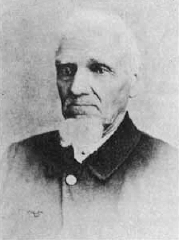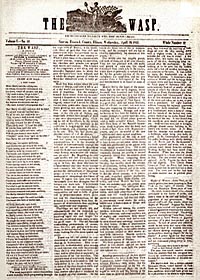William Smith (Mormon)
William B. Smith (born March 13, 1811 in Royalton , Vermont , † November 13, 1893 in Clayton County , Iowa ) was a Mormon leader and a member of the original Quorum of the Twelve Apostles . Smith was the eighth child of Joseph Smith, Sr. and Lucy Mack Smith . He was a younger brother of the Mormon Prophet Joseph Smith .
Early life
Smith was born in Royalton. He and his family were in dire straits and moved several times in the New England area . He was living at his parents' house in New York when his brother Joseph claimed to have taken the gold plates from Cumorah Hill . William told Joseph that he was not allowed to see the gold plates. However, he was allowed to touch what Joseph said was the gold plates. William was baptized into the Church of Christ on June 9, 1830 by David Whitmer , one of the three Witnesses.
Church service
On February 14, 1835, the three Witnesses elected a brother of Brigham Young as an original member of the Quorum of the Twelve Apostles . However, Joseph Smith insisted that his younger brother William be chosen instead. Oliver Cowdery and David Whitmer later reported that they were highly concerned and dissatisfied with this selection. William Smith was ordained an apostle on February 15.
On May 4, 1839, Smith and Orson Hyde were expelled from the Quorum of the Twelve Apostles by a Church vote. Even so, Smith was reinstated on May 25th. Smith was the editor of the pro-Mormon but secular newspaper The Wasp (German: The Wasp) in Nauvoo . He directed this newspaper from April to December 1842. Smith criticized the newspaper Warsaw Signal and its publisher Thomas C. Sharp particularly sharply . Smith resigned as editor of the newspaper when he was elected to the Illinois General Assembly . He was succeeded as editor by John Taylor . He ran the newspaper for five months and then replaced it with the Nauvoo Neighbor .
On May 24, 1845, Smith succeeded his brother Hyrum Smith as the Church's Supreme Patriarch . Shortly after his ordination, Brigham Young stated in a proclamation in a Church magazine that Smith was not the patriarch of the Church, but of the Church. Smith thought the announcement was a cheek and it increased tension between him and Young. Smith was the Church's Supreme Patriarch until October 6, 1845, when his name and title were read in general conference . The Apostle Parley P. Pratt publicly stated that he had doubts about Smith's character and actions. The conference participants then unanimously decided that Smith should lose his offices as apostle and patriarch and be expelled from the congregation. Smith responded by making a long statement in his enemy's newspaper, the Warsaw Signal . In this he compared Young with Pontius Pilate and Nero . He accused Young and other apostles of secretly keeping several "spiritual wives". In response to this declaration, Smith was excommunicated by Young and the other apostles on October 19, 1845 .
Relationship with Joseph Smith
The relationship between William and his older brother Joseph was very difficult at times. It is believed that William participated in more than two attempts to physically harm his brother. A fight between the two of them was narrowly prevented in October 1835. A few weeks later, in December, the two of them had an argument at a debating school in their father's house. It is said that at the time of his death, Joseph still felt the pain he suffered in that argument.
Later involvement in Mormon groups
As a result of Smith's excommunication, he did not follow Young and the majority of Mormons to the Utah Territory . Instead, Smith followed James Strang and participated in his church, The Church of Jesus Christ of Latter-day Saints (Strangites) . In 1847 Smith announced that he was the new President of the Church and that he had the right to rule because of his bloodline. He excommunicated Young and LDS Church leaders, and announced that all Mormons who disobey them should rally in Lee County . In 1849 he won over a fellow campaigner who led a group of Mormons in Texas. However, the Smith Church was short lived and after a few years it disintegrated.
Smith and Young's relationship remained problematic until Young's death in 1877. Smith believed that Young was responsible for the poisoning of his older brother Samuel. This was supposedly to prevent his ascension as President of the Church. However, Smith wrote a letter to Young in 1860. In that letter he stated his intention to join the Mormons in the Salt Lake Valley . Shortly after sending the letter, Smith became a soldier in the Civil War . After that he didn't want to move to the Utah Territory anymore .
In 1878 Smith became a member of the Communion of Christ . This was organized and directed in 1860 by his nephew Joseph Smith III . The majority of Smith's followers became members of this Church. While Smith believed he had the right to become a patriarch or an apostle in the fellowship of Christ, his nephew was against such aspirations. William Smith remained a high priest in the fellowship of Christ for the rest of his life. Today Smith is referred to as a "petitioner for the patriarchy" by the fellowship of Christ. He tried to become a patriarch from April 6, 1872 until his death.
politics
Smith served one term in the Illinois General Assembly , in 1842 and 1843. He was elected to the Illinois House of Representatives as a representative of Hancock County . Smith was a member of the Democratic Party when he ran for election. Its main competitor was Thomas C. Sharp of the United States Whig Party . It was easy for Smith to win this election because of the huge Mormon support from Nauvoo .
death
Smith died in Clayton County . He was the last brother of Joseph Smith to die.
Publications
- William Smith (1842–1842, newspaper). The Wasp (Nauvoo, Illinois: LDS Church)
- William Smith (spring 1844). To the public. Slander Refuted! An Extract from Church Proceedings; and Expulsion of Mormon Apostates, from the Church! (Philadelphia: self-published)
- William Smith (spring 1844). Defense of Elder Wm. Smith, Against the Slanders of Abraham Burtis and others (Philadelphia: self-published)
- William Smith (late 1844). The Elders' Pocket Companion (unknown location: self-published)
- William Smith (June 1845). A Proclamation, and Faithful Warning to all the Saints scattered around ... (Galena, Illinois: self-published)
- William Smith (October 1845). Faithful Warning to the Latter Day Saints [shorter version of A Proclamation .] (St. Louis, Missouri: self-published)
- William Smith, Arthur Millikin, and Lucy Millikin (April 1846). To the Public (Nauvoo, Illinois: self-published)
- William Smith (September 1847). William Smith, Patriarch & Prophet of the Most High God - Latter Day Saints, Beware of Imposition! (Ottawa, Illinois: Free Press)
- William Smith (November 1848). A Revelation Given to William Smith, in 1847, on the Apostasy of the Church .... (Philadelphia: self-published)
- William Smith and Isaac Sheen (1849–1850, newspaper). Melchizedek & Aaronic Herald (Covington, Kentucky: Isaac Sheen)
- William Smith et al. (1850) Remonstrance of William Smith et al., Of Covington, Kentucky. Against the Admission of Deseret into the Union. (Washington DC: US Government)
- William Smith (1883). William Smith on Mormonism: A True Account of the Origin of the Book of Mormon (Lamoni, Iowa: RLDS Church)
literature
- Irene M. Bates, "William Smith, 1811-93: Problem Patriarch" , Dialogue: A Journal of Mormon Thought , vol. 16 , no. 2 (1983), pp. 11-23
- Paul M. Edwards, "William B. Smith: The Persistent, Pretender '" , Dialogue: A Journal of Mormon Thought , vol. 18 , no. 2 (1985), pp. 128-139
Individual evidence
- ↑ Oliver Cowdery to Brigham Young, February 27, 1848, and interview by Zenas H. Gurley Jr. with David Whitmer, January 14, 1885; both in the LDS Church History Library.
- ^ History of the Church 3 : 345.
- ^ History of the Church 3 : 364.
- ↑ a b Jerry C. Jolley, "The Sting of the Wasp: Early Nauvoo Newspaper — April 1842 to April 1843" , 22 BYU Studies (Fall 1982) 487-96.
- ^ Wasp , April 30, 1842, p. 2.
- ↑ Darwin L. Hays, “Nauvoo Neighbor” in Daniel H. Ludlow (ed.) (1992). Encyclopedia of Mormonism . (New York: Macmillan) p. 999.
- ^ History of the Church 7 : 418.
- ↑ "Patriarchy" ( page no longer available , search in web archives ) Info: The link was automatically marked as defective. Please check the link according to the instructions and then remove this notice. , Times and Seasons , vol. 6, no.10 (June 1, 1845), pp. 920-22.
- ^ BH Roberts (ed.), History of the Church 7 : 457-59.
- ^ Hosea Stout journal, October 6, 1845.
- ↑ William Smith, "A Proclamation" , Warsaw Signal , October 29, 1845th
- ^ BH Roberts (ed.), History of the Church 7 : 483.
- ^ History of the Church 2 : 294-95.
- ↑ Arnold K. Garr, “Joseph Smith: Man of Forgiveness,” in Susan Easton Black and Charles D. Tate Jr. (Editors): Joseph Smith: The Prophet, The Man (Provo, Utah: Religious Studies Center, Brigham Young University, 1993) pp. 127-36.
- ^ History of the Church 2 : 334-35.
- ↑ Andrew Jenson. Latter-day Saint Biographical Encyclopedia 1 : 87.
- ↑ a b c d J. Gordon Melton (1996, 5th ed.). Encyclopedia of American Religions (Detroit, Michigan: Gale), p. 576.
- ^ Jon Krakauer (2003). Under the Banner of Heaven: A Story of Violent Faith (New York: Doubleday), p. 194.
- ↑ D. Michael Quinn (1994). The Mormon Hierarchy: Origins of Power (Salt Lake City, Utah: Signature Books) pp. 152–53.
- ↑ William Smith, "Mormonism: A Letter from William Smith Brother of Joseph the Prophet," , New York Tribune , May 19th. 1857
- ^ Paul M. Edwards, "William B. Smith: The Persistent 'Pretender'" " ( Memento of the original from June 13, 2011 in the Internet Archive ) Info: The archive link was automatically inserted and not yet checked. Please check the original and archive link according to the instructions and then remove this notice. , Dialogue: A Journal of Mormon Thought , vol. 18 , no. 2 (1985) pp. 128-39.
- ^ Paul M. Edwards, "William B. Smith: The Persistent 'Pretender'" " ( Memento of the original from June 13, 2011 in the Internet Archive ) Info: The archive link was automatically inserted and not yet checked. Please check the original and archive link according to the instructions and then remove this notice. , Dialogue: A Journal of Mormon Thought , vol. 18 , no. 2 (1985), pp. 128-39.
- ↑ Howard, Richard P. Lesson 2: A Brief Historical Survey of the Ministry of the Evangelist-Patriarch ( Memento of the original from November 22, 2010 in the Internet Archive ) Info: The archive link was automatically inserted and not yet checked. Please check the original and archive link according to the instructions and then remove this notice. , page 13. Temple School Course PA 222: Evangelists: Sharing a New World of Blessing, Community of Christ.
- ↑ James B. Allen and Glen E. Leonard (1976). The Story of the Latter-day Saints . (Salt Lake City, Utah: Deseret Book ) p. 177.
| personal data | |
|---|---|
| SURNAME | Smith, William |
| ALTERNATIVE NAMES | Smith, William B. |
| BRIEF DESCRIPTION | younger brother of the Mormon Prophet Joseph Smith |
| DATE OF BIRTH | March 13, 1811 |
| PLACE OF BIRTH | Royalton , Vermont |
| DATE OF DEATH | November 13, 1893 |
| Place of death | Clayton County , Iowa |

